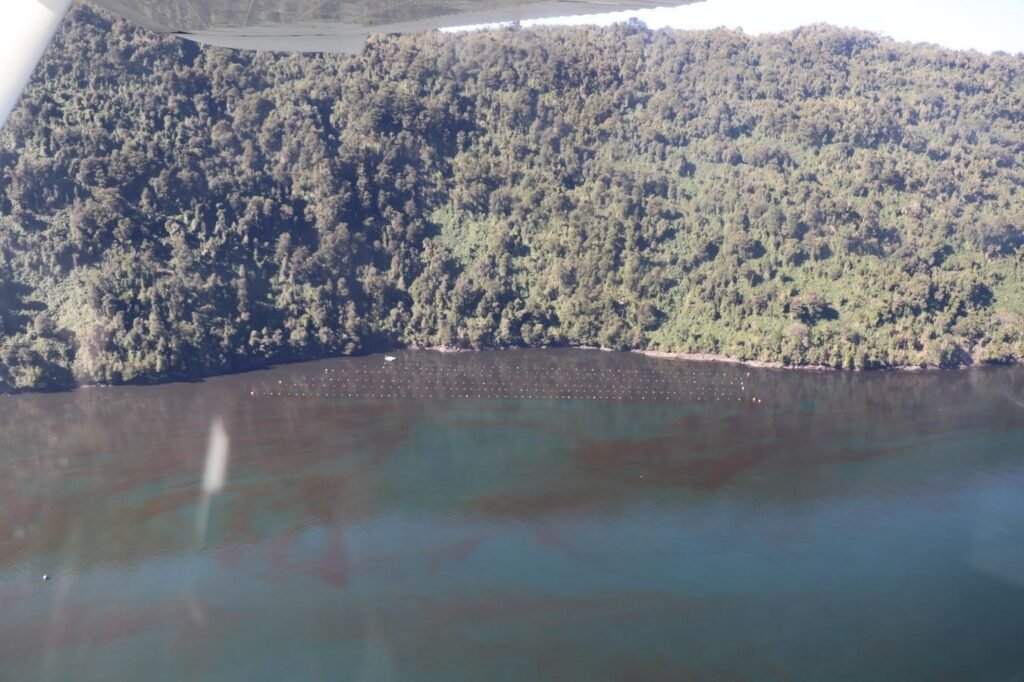A new event of Harmful Algal Blooms (HABs, commonly known as “red tide”), has been detected near … [+]
Chilean researchers investigate a ‘red tide’ Heterosigma akashiwo algal bloom in early April 2024, — possibly caused by a changing climate.
“Red tide” blooms are a natural phenomenon caused by the exponential growth of microalgae, giving the ocean a reddish, green or brown hue, but they can also harm people, animals or the local ecology: in 1972, three fishermen were the first recorded deaths in Chilean Patagonia attributed to toxins.
Andrea Corredor-Acostaresearcher at the Center for High Latitude Marine Ecosystem Dynamics Research (IDEAL) at the Universidad Austral de Chile, says her research focuses on using satellite and field data to monitor changes in the annual cycles of microalgae growth off the coast of Chile Patagonia and the West Antarctic Peninsula.
“As this type of environmental forcing has changed as a function of global climate variability, changes in the productive activity of these microalgae are also expected,” he says, “Under this climate change scenario, some phytoplankton species become more sensitive to oceanographic/climate variability in various areas of Patagonia, in many cases promoting potentially harmful algal blooms (HABs).”
To understand the causes of this latest event at Hornopiren in the Patagonia region of Chile, an expedition led by Dr. oceanography, toxicology, fish dissection, meteorology and aerial flight.
Mardones explained that the aquaculture industry, academia and state-affiliated institutions tasked with monitoring and environmental assessment related to HABs have been waiting for months with uncertainty about where and when such an event would occur. fact.
“We are learning step by step how to interpret the biological, oceanic, and biological, oceanic, and climate signals that warn us of a higher likelihood of HAB occurrence in Patagonia,” he says.
Andrea Corredor-Acosta, of the Universidad Austral de Chile, during the EXOFAN research cruise in … [+]
From the Andes to the Cold Seas
Corredor-Acosta was born and raised in Bogotá, Colombia, but she also had the opportunity to swim off Colombia’s Caribbean coast with one of her uncles, a marine biologist.
“Such a wealth of marine life and color was always shocking to me,” she says, adding that it was during her undergraduate studies in physics at the Universidad Distrital Francisco José de Caldas, in Bogotá, that she realized she wanted to focus on characterizing the ocean. circulation under different climate regimes using satellite imagery in the Colombian Pacific.
“My experience developing this paper was spectacular, there was a world to learn, work and research,” says Corredor-Acosta, adding that she would go on to earn a Master of Science in Exact Sciences and a PhD in Oceanography at Concepción University , Chile.
For her postdoctoral studies, Corredor-Acosta arrived at IDEAL in Chile.
“During these years of specialization, my research focus was mainly oriented towards investigating the coupling of phytoplankton life cycles with the surrounding oceanographic conditions and this in turn with climate variability off the Colombian Pacific coast and of Chile,” he says.
Corredor-Acosta explains that Patagonia’s seas and coasts are a highly diverse system that is increasingly vulnerable to climate change and human impacts.
“An analysis of how these interactions have changed in recent decades will allow us to project how this region, and others of similar characteristics elsewhere on the planet, will potentially change in the near future,” he says.
A new event of Harmful Algal Blooms (HABs, commonly known as “red tide”), has been detected near … [+]
Documentation Blooms in Patagonia
Another researcher working on algal blooms in Patagonia is José Luis Iriarte, an oceanographer working at Universidad Austral de Chile and principal investigator at IDEAL in Punta Arenas, Chile.
Corredor-Acosta’s postdoctoral supervisor, was the scientific leader of 24 Chilean and foreign scientists on the Chilean Navy scientific vessel Cabo de Hornos in 2023, with a documentary crew also capturing the mission on film.
The team aimed to detect new toxins in the southern marine system, as well as learn about environmental factors that may explain the distribution of toxic blooms.
Iriarte says several toxin-producing marine species have been spotted along Patagonia’s coast, including new ones that affect fish, as well as those that cause paralysis and food poisoning in humans (known as red tide poisoning).
“It is a scientific challenge to understand how toxic species along the coast could be related to unknown environmental climatological-hydrological and oceanographic features combined with a changing ocean scenario,” he says.
